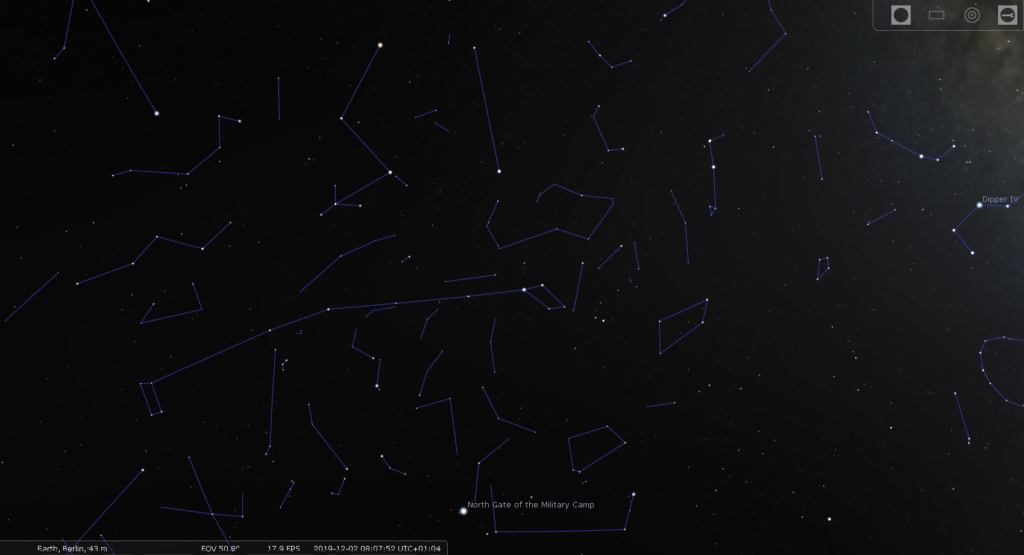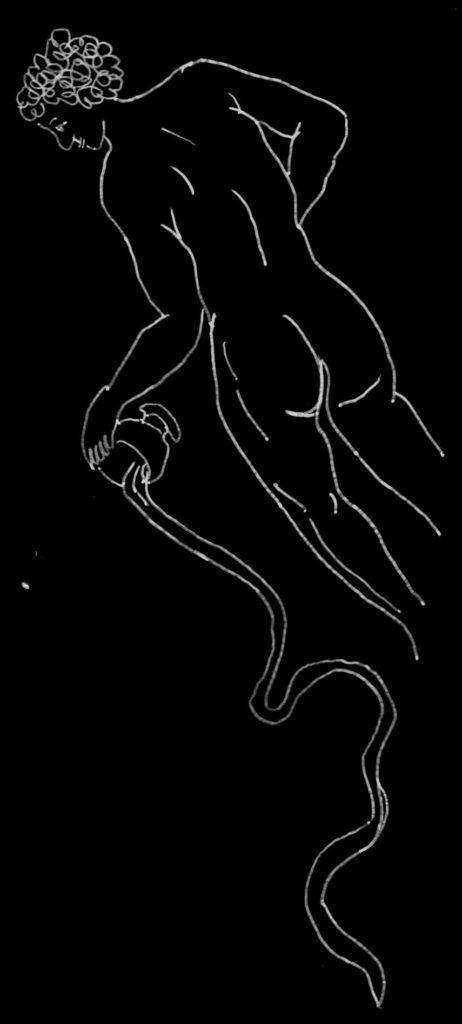Tür 16: Steinbock und Wassermann

Auch diese beiden Sternbilder gehören zusammen: Der Steinbock – bzw. eigentlich eine Ziege oder am Himmel der gutmütige Dämon “Ziegenfisch” – ist ein Attributtier des Gottes, den wir heute “Wassermann” nennen.
Steinbock/ Ziegenfisch
Der Steinbock heißt griechisch eigentlich “der Ziegengehörnte” und babylonisch “der Ziegenfisch”. In der babylonischen Ikonographie gehört dieses Mischwesen ganz automatisch zum Gott der Weisheit Ea/ Enki und wurde wahrscheinlich deshalb auch am Himmel daneben verstirnt. Das würde erklären, warum auch dieses Bild an einem der Kardinalpunkte mit Unanschaulichkeit glänzt. Die Karninalpunkte, also die Tag- und Nachtgleichen und Sonnenwenden, sind demnach alle vier mit unanschaulichen Figuren in sternarmen Gegenden markiert: Die Wintersonnenwende durch den Ziegenfisch, die Frühlingstag- und -nachtgleiche mit dem Widder, die Sommersonnenwende durch den Krebs und die Herbsttag- und -nachtgleiche mit der Waage. Bei Widder, Krebs und Waage lassen sich Eselsbrücken aus dem Kalender finden (die Lämmerspringe, der Krebsgang der Sonne und dass sich “Tag und Nacht die Waage halten”)… aber der Ziegenfisch bleibt ein Exot. In griechischen literarischen Texten wird spekuliert, ob es sich bei dem Mischwesen um Agipan handelt, der Ziegenhörner hat, aber bei einer Verwandlung, die schnell gehen musste, weil er auf der Flucht war, mal einen Fehler (Halbwandlung in einen Fisch) gemacht hat. Wenn die griechische Mythologie solche Klimmzüge macht, um eine “Erklärung” zu finden, lässt es darauf schließen, dass sie keine Ahnung hat, wie das Wesen aus einer fremden Kultur einzuordnen ist. Ob er auf dem Atlas Farnese einen Fischschwanz hat oder nicht, weiß niemand, denn die Schulter des Titanen verdeckt ihn: Man sieht nur den Kopf mit den Ziegenhörnen auf dem steinernen Globus hervorluken [ich habe ihn darum nicht für die Planetariumsdarstellung gezeichnet]. Auf dem Mainzer Globus und dem Kugel-Globus ist er als Mischwesen unverkennbar.
Babylonisch war es ein guter Dämon, der für alle möglichen Sachen und insbesondere in der Medizin um Hilfe gebeten wurde.
Door 16: Capricornus and Aquarius
These two constellations also belong together: Capricorn – or actually a goat, or in the sky the good-natured demon “goatfish” – is an attribute animal of the god we now call “Aquarius”.
Capricorn/ Goatfish
The Capricorn is actually called “the goat-horned one” in Greek and “the goat-fish” in Babylonian. In Babylonian iconography, this mixed creature automatically belongs to the god of wisdom Ea/ Enki and was probably therefore also stencilled in the sky next to it. This would explain why this image also shines with obscurity at one of the cardinal points. The cardinal points, i.e. the equinoxes and solstices, are thus all four marked with inapparent figures in star-poor regions: The winter solstice by the goatfish, the spring equinox with Aries, the summer solstice by Cancer and the autumn equinox with Libra. With Aries, Cancer and Libra, mnemonic bridges can be found from the calendar (the lambing leap, the cancerous passage of the sun and that “day and night balance each other”)… but the goatfish remains an exotic. Greek literary texts speculate whether the hybrid creature is Agipan, who has goat horns but once made a mistake (half-transformation into a fish) during a transformation that had to happen quickly because he was on the run. When Greek mythology makes such clumsy moves to find an “explanation”, it suggests that it has no idea how to classify the being from a foreign culture. Whether or not he has a fish tail on the Atlas Farnese, no one knows, because the Titan’s shoulder hides it: you can only see the head with the goat’s horns peeking out on the stone globe [that’s why I didn’t draw it for the planetarium representation]. On the Mainz globe and the spherical globe he is unmistakable as a hybrid being.
Babylonian it was a good demon who was asked for help for all kinds of things and especially in medicine.
Wassermann
Aquarius
He accompanies the god of wisdom, who typically lives in fresh groundwater. His iconography was therefore Babylonian, with two rivers flowing from his shoulders (who would be surprised: they are called the Euphrates and Tigris and are marked in reliefs and on scroll seals as life-giving rivers by having fish painted in them). This figure of a man with water flowing from his shoulder was of course also incomprehensible to the Greeks – especially since their wisdom god was female (Athena, for example, is a wisdom goddess, among other things, and then there are the allegories Episteme for knowledge and Sophia for wisdom…). For them, the great, powerful and good-natured Babylonian god was therefore simply “the Aquarius” and because everyone knows that water does not spring from shoulders, they gave him an amphora for it. This is how he is immortalised on the Atlas Farnese:
China
Wenig überraschen wird nun die meisten Leser, dass auch diese Sternbilder in zahlreiche kleine geteilt waren: Die Hörner unsers Steinbox bilden die chinesischen Ochsen, dann kommen verschiedene Staaten (bzw. ihre himmlischen Repräsentationen) und durch den Wassermann erstreckt sich quer ein riesiges Bollwerk.
China
It will come as little surprise to most readers that these constellations were also divided into numerous smaller ones: The horns of our stone box form the Chinese oxen, then come various states (or their celestial representations) and across Aquarius stretches a huge bulwark.



